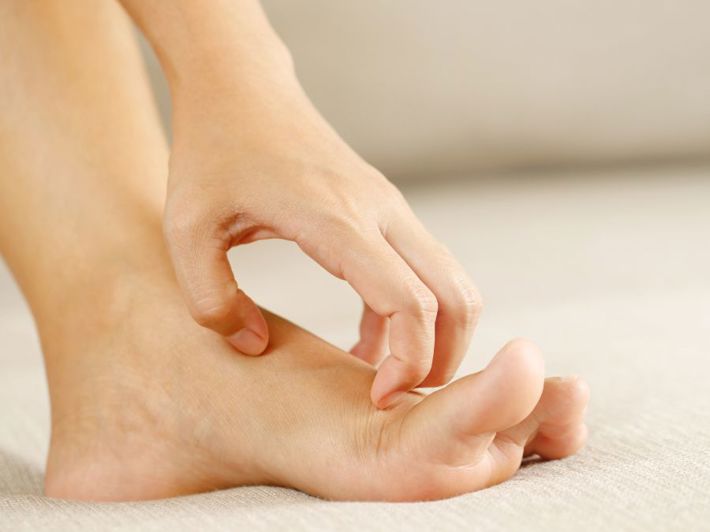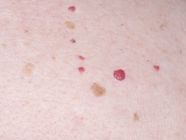Foot fungus refers to a group of fungal infections that affect the skin and nails of the foot. The most common types include: (1)
- Athlete’s Foot, typically affecting the skin between the toes and the soles.
- Toenail Fungus, which affects the nails directly, causing discoloration and thickening.
Both types are caused by the same group of fungi that thrive in warm, moist environments—like tight shoes and damp socks—and often lead to itching, redness, and peeling. If left untreated, the infection can spread to other parts of the body. Here's how to treat foot fungus. (1)
How to Treat Foot Fungus
Most cases of foot fungus can be treated with over-the-counter topical antifungal medications. In more severe or persistent cases, oral antifungal medications may be required. Lifestyle changes also play a vital role in both treatment and prevention. (2)(3)
1. Topical Antifungal Medications
(Creams, Ointments, Sprays, Powders, etc.)
Topical antifungal medications include:
- Clotrimazole (Canesten, Clozole)
- Miconazole (Daktacort, Mycoheal, Miconaz)
- Terbinafine (Lamisil)
2. Oral Antifungal Medications:
In severe cases or when topical treatments are not effective, doctors may prescribe oral antifungal medications such as:
- Fluconazole (Diflucan, Flucand)
- Itraconazole (Conazole, Itrazol)
- Terbinafine (Lamifen, Lamisil)
Important Notes:
- Combination Therapy: In more severe cases, the doctor may recommend using both topical and oral antifungal medications together.
- Treating Nail Fungus May Take Longer: Because nails are thick, it’s often difficult for creams and ointments to reach the fungi underneath. This makes nail fungus harder to treat and may require longer treatment durations or prescription oral antifungals.
- Do Not Stop Treatment Early: Continue the full course of treatment, even if symptoms disappear, to ensure the infection is fully eliminated and prevent recurrence.
- Consult a Dermatologist if There’s No Improvement or Recurrence: In some cases, a lab test (culture) may be needed to identify the specific fungus and determine the most effective treatment.
Treatment Tips & Prevention
Adopting these daily care tips can speed up healing and prevent future infections: (4)(5)
- Wash your feet daily with warm water and mild soap.
- Dry your feet thoroughly, especially between the toes, before applying any topical products.
- Use antifungal powder like Eva Foot only on intact, mildly moist skin—never on broken or inflamed skin.
- Wear breathable cotton socks and change them daily, especially after sweating or exercise.
- Air out your shoes and alternate pairs frequently.
- Choose well-ventilated, properly fitting footwear.
- Never share shoes, socks, or towels with others.
- Disinfect personal care tools like nail clippers and files.
- Keep toenails clean, trimmed, and dry.
- Avoid walking barefoot in public areas like pools or locker rooms.
- Never scratch the infected area to avoid spreading the infection.
When Should You See a Doctor?
Seek medical attention immediately if: (4)
- The infection does not improve with OTC treatment.
- You experience severe pain in your feet.
- You notice redness, swelling, or warmth, which could signal a bacterial infection.
- The infection spreads to other areas of the body.
- You have diabetes, as fungal infections may lead to complications.
Frequently Asked Questions
How long does foot fungus treatment take?
For athlete’s foot, noticeable improvement often appears within 4 weeks.
Toenail fungus may require 6–12 months of consistent treatment. (4)(5)
Can foot fungus come back?
Yes. It’s common for fungal infections to recur, especially if:
- The full treatment course is not completed.
- The original source of infection remains untreated.
- You’re regularly exposed to warm, damp environments.
- You have a weakened immune system.
Need Help?
At Al-Ahli Hospital’s Dermatology Department, our specialized team provides comprehensive care for foot fungal infections using the latest techniques. Book your appointment now and say goodbye to persistent fungal infections. Don't hesitate to book an appointment.
References
- Types of Foot Fungus and Bacterial Infections, Verywell Health
- Nail fungus: Diagnosis and treatment, American Academy of Dermatology Association
- Understanding Athlete's Foot: The Basics, WebMD
- Fungal nail infection, NHS
- Athlete's foot - Diagnosis and treatment, Mayo Clinic






